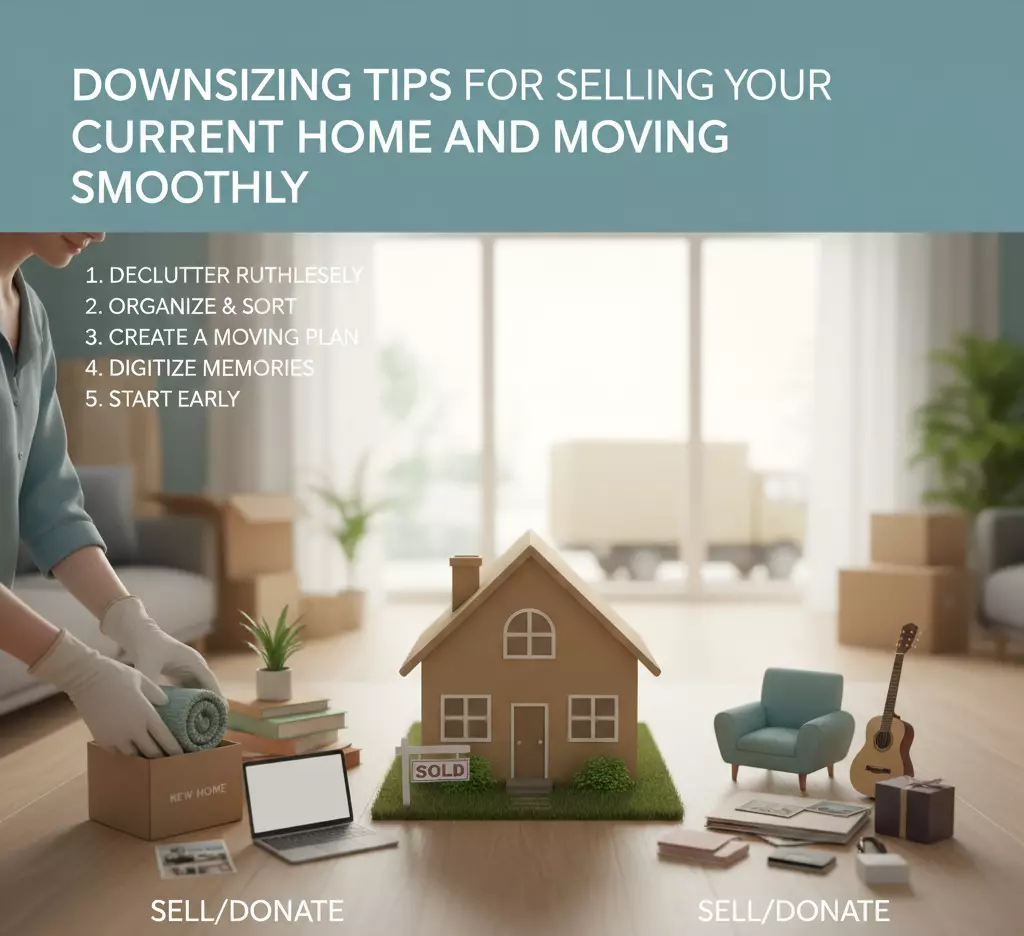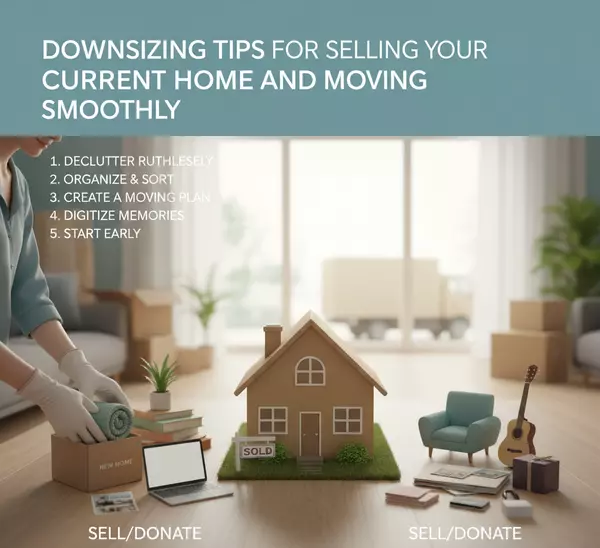Downsizing? Tips for Selling Your Current Home and Moving Smoothly

Downsizing is more than just moving to a smaller space; it's a major life transition. The process requires a double dose of effort: selling the large home you cherish, and simultaneously preparing for a smaller, streamlined lifestyle.
To sell quickly and make your transition smooth, you need a strategy that tackles the logistics, the finances, and the emotions all at once. Here is your roadmap for downsizing with success and minimal stress.
Part 1: Selling the Big House Smartly
When selling a large home, the biggest hurdle is making the space look manageable, not overwhelming.
- Declutter Before You List
- The Downsizing Filter: Use the sale process as your motivation to lighten the load. Before you list, pack and remove at least one-third of your belongings. You are not just staging; you are preparing for your new home.
- Focus on Storage Spaces: Closets, pantries, and garages must look half-empty. Move out bulky seasonal items, tools, and excessive linens into an off-site storage unit or portable pod. This is especially important when selling in space-conscious areas like Fairfax or Loudoun County, where maximizing the perception of space is key to a high valuation.
- Remove Bulk Furniture: Large, oversized furniture can make rooms feel smaller and block light. If a room feels crowded, remove one large piece (like an extra sofa or hutch) to improve flow for showings.
- Prepare for the Inspection & Appraisal
- Address Maintenance: In an older, larger home, deferred maintenance is a huge red flag. Focus on small, high-visibility fixes. A clean inspection report is critical for smooth closing and essential for gaining the confidence of demanding buyers in the competitive Northern Virginia market.
- Pricing for the Market: Work with your agent to ensure your price is based on recent comparable sales (comps). If you're selling a large, luxury home in a suburb like Great Falls or McLean, overpricing can lead to your home sitting on the market too long.
Part 2: The Financial and Timing Tangle
The logistics of closing one home and opening another is the trickiest part of downsizing.
- Master the Contingency Dance
- Contingency is Key: If you must sell your current home to buy the next one, you will need a sale contingency on your purchase offer. While common for downsizers, this makes your offer less competitive, particularly when buying a sought-after condo or townhome in Clarendon or Old Town Alexandria.
- Boost Your Offer Elsewhere: If you use a sale contingency, make your offer strong in other ways: provide a large Earnest Money Deposit (EMD), agree to quick closing, or waive non-essential contingencies.
- The Temporary Rental: If possible, move your belongings into storage and rent a short-term apartment for a month or two. This frees you from the sale contingency, allowing you to close on your current home and then shop for your new one as a non-contingent buyer giving you massive negotiating power when competing for a prime location in Arlington County.
- Understanding Net Proceeds
- Get a Realistic Estimate: Your agent can prepare a Seller Net Sheet that estimates your profit after paying off the mortgage, commissions, property taxes, and closing costs.
- Budget for Moving: Factor in the costs of moving, storage unit rentals, temporary housing, and minor repairs you may need to do at your new, smaller place.
Part 3: Streamlining Your New Life
Successful downsizing is defined by what you choose to take with you.
- The Three-Box Method
As you pack, process items with a clear designation: KEEP, SELL/DONATE, or STORE. Be aggressive if you haven't used it in two years, get rid of it. Consignment shops and local charities in Northern Virginia are your friends.
- Embrace the New Layout
- Measure Twice, Buy Once: Get the precise measurements of your new home's rooms and furniture walls. Only keeping furniture that you know will fit the scale and flow of the smaller space.
- Maximize Vertical Storage: Smaller homes often benefit from built-in shelving and multi-purpose furniture. This is especially crucial for maximizing compact living spaces commonly found throughout in Arlington.

Part 4: The Emotional and Practical Finish Line
Downsizing is an emotional event. Acknowledge the feelings while maintaining a practical focus.
- Handling Sentimental Items
- Take Photos First: Before selling or donating large items (like a large china cabinet), take high-quality photos.
- Pass It Down: Offer items you cannot take to relatives now.
- One Box Rule: Limit yourself to one or two small boxes for purely sentimental, non-essential "store" items.
- Legal and Administrative Cleanup
- Update Your Address Early: Update utility companies, banks, subscription services, and the post office.
- Transfer Utilities: Coordinate the turn-off date for your current home utilities and the turn-on date for your new home. In busy Northern Virginia locales, this often requires several weeks' notice.
- Review Homeowner’s Insurance: Call your insurance provider to terminate the policy on your sold home and activate a new, appropriate policy for your downsized residence before closing day.
- The Final Walk-Through Strategy
- Empty and Clean: The house should be professionally cleaned and truly empty.
- Leave Essentials: For the new buyer, leave a binder with important documents: appliance manuals, paint color cards, and notes on trash/recycling schedules, a helpful gesture often appreciated in the Arlington County area.
By tackling the clutter early, managing the financial timing with strategic planning, and addressing the emotional weight of leaving a cherished home, you can navigate the sale of your large home and move into your downsized life smoothly and happily.
Recent Posts











"My job is to find and attract mastery-based agents to the office, protect the culture, and make sure everyone is happy! "


